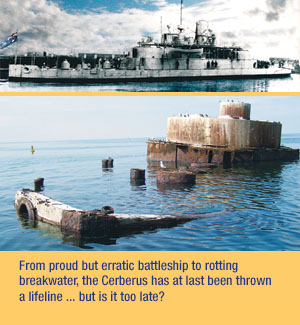RoyalAuto
Ship Of Shame

Port Phillip Bay might be the pride of Melbourne but rotting and collapsing down in one corner of it is the hulk of the pride of Victoria’s navy, the Cerberus, a victim of bureaucratic indifference and a heritage disgrace.
For eight decades it mattered little that this fighting ship, described by the National Trust as one of the most historically important naval vessels in existence anywhere in the world, stared extinction in the face, buffeted by waves as a makeshift breakwater at Half Moon Bay, Black Rock.
Only recently has the light of hope been cast on this shameful battleship-to-breakwater saga – and, short of a huge injection of funds, even this last-ditch restoration attempt might be too late.
In nearly all respects, the Cerberus, one of just three Monitor-class vessels left in the world, was revolutionary, and her role a vital one. With the Crimean War just over, gold-rich Victoria was panicky and believed it desperately needed protection from Russian raiders and other unfriendly vessels. The Cerberus, her revolving big guns able to fire at least 5km, was commissioned as the saviour.
A floating gun platform, her role would be to sit low in the water (achieved via ballast tanks) just inside the Port Phillip Heads and, aided by batteries on either head, blast any invader to smithereens. She would be the cork in the bottle of the heads, able to seal off Melbourne from attack.
Launched on 2 December 1868 on the Tyne in the north of England, the armour-plated vessel was named after the three-headed dog in Greek mythology that guarded the entrance to the “lower-world” – in this case Melbourne.
And although she never fired a shot in true anger, she was the centre of hostilities even before leaving England after construction. Some crew feared for their lives and a police boat patrolled at night to prevent them jumping ship.
The reason was her alarming design. Because of a flat bottom and shallow draught, she had appalling steering and rudder habits that would plague her for much of her life. And early on she heeled six degrees to starboard because both shell rooms were on that side.
Yet despite predictions she would never arrive, Cerberus was hailed a giant-killer when she entered Port Phillip Bay on 9 April 1871 to join the Victorian Navy, then comprising HMVS Nelson, the sloop Victoria and steamer Pharos.
By August 1871, the Cerberus was strutting her stuff around the Bay, with dignitaries queuing to go on board. But with decks regularly awash and a cramped flying deck, most went away damp in spirits.
Melbourne loved the good ship Cerberus, even pardoning her when in 1875 an apparent earthquake turned out to be nothing more than this dreadnought firing her guns, or when while trying to intercept a trading vessel avoiding Melbourne customs she blew the roof off a St Kilda pharmacy and hit the Gellibrand Lighthouse because of a sudden tide change as she fired warning shots.
As naval technology progressed, Cerberus’s prowess quickly declined. By the 1920s she was considered “aged and decrepit, disembowelled, almost dead”, and her resting place was the “ships’ knacker’s yard” at Williamstown.
On 3 September 1926 her final indignity came when tugs towed her to Black Rock where she was scuttled to become a breakwater where she lies today. She had been sold to the Black Rock Yacht Club for £150, then later resold to the local council to become the shameful disgrace she is today, collapsed and deteriorating in 3m of water.
But after decades of neglect, the tide has turned a little. Last year the State Government funded the removal of the ships’ four 18-tonne guns. Now lying next to the vessel with protective covering over them, hopefully they can later be returned to the Cerberus. Then on 14 December came the biggest breakthrough, the inclusion of the vessel on the National Heritage List for her outstanding significance to the nation. One of only 22 listings, she was ranked higher than even the MCG. The listing was applauded as a prerequisite for state and federal governments to jointly fund further stabilisation projects.
Meantime, the condition of this piece of Victorian history is still critical. While gun removal eased the load on the vessel, danger of collapse remains. Two turrets, which weigh more than 200 tonnes, are held up by just a few internal supports and deck beams, estimated to be supporting a weight four times more than their design capacity.
Now the best option is to place her on an underwater cradle at a cost of about $5.5 million, still considered a bargain. That would stabilise her for about 50 years. Meantime, sanity and a full-on restoration project just might eventuate.
As Peter Tully, secretary of The Friends of the Cerberus stresses, if Cerberus were in America or Britain, she would have been preserved years ago. “Australians should cherish their heritage,” he says. “It would be a tragedy of major proportions if we permitted Cerberus to collapse.”
Tony Fawcett
Join the Victorian Navy
At its peak, the Victorian Navy boasted 16 vessels, including the flagship Cerberus. With Federation, the state navy became part of the Royal Australian Navy. But now those interested in learning about the Cerberus and donating to its hopeful restoration can again join the Victorian Navy.
This time around it is the not-for-profit membership arm of Friends of the Cerberus. Join up as a full member and you can even choose your rank from nearly 50 categories.
For a $100 donation you can become a commander, or $80 will bring the rank of lieutenant-commander, while $30 will make you a ship’s cook or carpenter’s mate. For $20, choices include able seaman and stoker.
Those who don’t donate can become associate members, receiving a choice of rank from training seaman, boy, officer’s servant or crew member. Visit www.cerberus.com.au